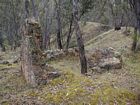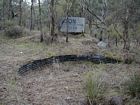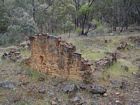At the peak of the gold rush in the 1850s, Castlemaine was home to almost 30,000 miners and was considered to be the richest goldfield in the world. The rush of miners was instrumental to the changes that came about in the colony in the years that followed, the increase of wealth and democratic values, improved mining techniques and technologies, the introduction and improvement of services, infrastructure and facilities and a great deal of cultural diversity.
In 2002 parts of the former site of the Castlemaine diggings (Vaughan Mineral Springs Reserve, Castlemaine-Chewton Historic Area, Upper Loddon Flora Reserve and areas of State Forest) became the Castlemaine Diggings National Heritage Park. The Park, stretching from north of Chewton, south through the Fryerstown and Vaughan Springs areas, encompasses an area of approximately 7,500 ha. Most of the area is covered with regrowth Box-Ironbark forest which has been harvested to supply fuel and timber for mines and other local industry.
The Diggings and the site of the Eureka Stockade have been placed on the National Heritage List, because they help to tell the story of the gold rush and its impact on Victoria and Australia. Being included on this List means that the site is protected from any changes or alterations that threaten the significant characteristics identified.
The National Heritage List has a set of nine criteria by which all potential inclusions on the List are measured. These criteria were created to ensure that all of the places that are on the register help us to tell stories about people or about the land. These places should have ‘outstanding heritage values’ and help us to understand something about the nation’s past.
The Castlemaine Diggings National Heritage Park has been assessed against the below criteria, and accepted on the basis of the following:
The site’s national importance in Australia’s cultural history – There were more than 30,000 miners in Castlemaine, this influx of people broadened the nation’s cultural diversity and motivated rapid social change. The site also has evidence of a diversity of mining methods over a large time period and a variety of habitation sights which provide insight into living on the goldfields.
The site carries evidence of a rare aspect of Australian cultural history – There is a wealth of evidence regarding early mining techniques that are no longer practised, and evidence of the experience of living on a goldfield.
The site’s potential to contribute further to our understanding of Australia’s cultural history – There is potential new information, especially from the nineteenth century, regarding mining techniques and goldfield habitation to be gleaned from the site.
The place demonstrates characteristics of a class of Australia’s cultural places or cultural environments – The site provides examples of alluvial workings throughout the nineteenth and twentieth centuries. It also presents a view of what it was like to be a miner living on the goldfields with examples of ruined huts and houses which embody this lifestyle.
The place’s importance in exhibiting particular aesthetic characteristics valued by a community or cultural group – Due to the isolation and the regenerating forest, as well as the remains of mines and habitation sites, the Castlemaine goldfields gives its vistors the feeling of a past place and time.
Preservation of the site will help future generations to interpret the past and the present, and help us better understand an event that has had an enormous national impact, as well as a way of life that no longer exists in Australia.




